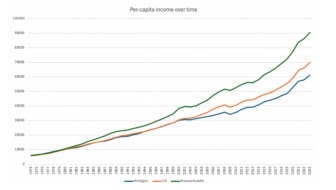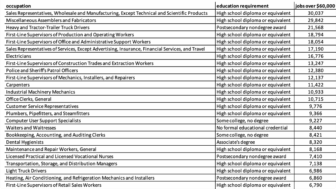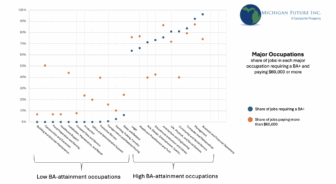The Michigan Association of United Way’s ALICE report is the best calculation of the proportion of Michigan households that![]() cannot afford basic necessities. That 40 percent of Michigan households––in a strong economy––can’t pay for basic necessities should be sending off alarm bells among policymakers that the Michigan economy is leaving far too many Michiganders behind.
cannot afford basic necessities. That 40 percent of Michigan households––in a strong economy––can’t pay for basic necessities should be sending off alarm bells among policymakers that the Michigan economy is leaving far too many Michiganders behind.
What the ALICE report doesn’t allow us to do is compare Michigan to the nation and other states. Nor does it allow us to determine the long term trend. Is the proportion of ALICE households growing or shrinking compared to the last time Michigan had a strong economy at the turn of the century?
Using 2016 American Community Survey data and the 2000 Census we calculated the proportion of Michigan households with incomes of two times the federal poverty level or below for all states and the nation. Two times the federal poverty level is a lower income level than ALICE. For a family with two adults and two children its about $48,000 in household income compared to an ALICE level of about $56,000. (Unlike the ALICE data, the poverty level is not cost of living adjusted by county.)
In 2016 32.6 percent of Michigan households had income equal to or below two times the federal poverty level. Compared to 26.4 percent in 1999––the last time Michigan had a strong economy and strong domestic auto industry. Nationally 31.8 percent of households in 2016 had income equal to or below two times the federal poverty level up from 29.7 percent in 1999. So Michigan has moved from 3.3 percentage points fewer lower income households to 0.8 percentage points more lower income households compared to the nation since the turn of the century.
What about Minnesota––the Great Lakes most prosperous state? In 1999 21.6 percent of Minnesota’s households had income equal to or below two time the federal poverty level. In 2016 that had risen to 24.3 percent. So the proportion of lower income households in Michigan compared to Minnesota has grown from 4.8 percent to 8.3 percent more.
Why has the proportion of Michigan households with income equal to or below the federal poverty level grown since 1999 and risen faster here than the nation or Minnesota? Two chief reasons:
- Too many of us not working. In 2000 Michigan was two percentage points above the national average in the proportion of those 16 and older working; in 2017 the state was 1.5 percentage points below. If the same proportion of Michiganders worked as Minnesotans there would be more than 725,000 more Michiganders working.
- Too many Michiganders working in low wage and benefit jobs. In 2000 Michigan was one percent below the national average in employment earnings (wages and employer paid benefits) per capita; in 2016 the state was 13 percent below. (Minnesota is 10 percent above the national average.)
This, of course, is more evidence that now is not the time for celebration as way too many of our political and business leadership are doing. Rather this is evidence of the need to establish a rising household income for all as THE mission of state economic policy. The rising proportion of lower income Michigan households compared to the last time Michigan had such a low unemployment rate and strong auto industry should make clear to political and business leaders that one can no longer assume that a low unemployment rate, strong and growing economy, and/or high business climate ratings provides an economy that is benefitting all.
In our Path to Good-paying Careers for All Michiganders report we lay out our ideas for the state policies that can best meet the goal of a rising household income for all.







